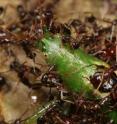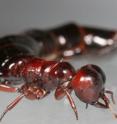Orphan army ants join nearby colonies
Related images
(click to enlarge)
Colonies of army ants, whose long columns and marauding habits are the stuff of natural-history legend, are usually antagonistic to each other, attacking soldiers from rival colonies in border disputes that keep the colonies separate. But new work by a researcher at the Harvard Museum of Comparative Zoology and colleagues at the University of Copenhagen shows that in some cases the colonies can be cooperative instead of combative. In those cases, when an army ant colony loses its queen, its workers are absorbed, not killed, by neighboring colonies, and within days are treated as part of the family.
The research, conducted in an ant-rich area on the slopes of Mount Kenya, is detailed in the journal Proceedings of the Royal Society B.
Army ant colonies are dominated by a single, large queen who produces the eggs that give rise to all of the colony's individuals, which can number millions of workers. When she dies, colonies quickly disappear, raising the question of what happens to the many individuals.
The work was conducted by Daniel Kronauer, a junior fellow in Harvard's Society of Fellows, over two field seasons in Kenya. Kronauer and his colleagues followed the fates of 10 army ant colonies whose queens they had removed. The researchers lost track of two of the colonies but observed two distinct strategies used by the remaining eight.
Most of the queenless colonies, seven out of 10, simply joined a neighboring colony -- determined by genetic analysis -- with the new workers slowly losing their distinct colony odor, and within days becoming fully integrated.
The last queenless colony stayed on its own, with workers employing a strategy of producing a small brood of winged males. Though these males were removed for analysis, in an undisturbed colony the males would fly off looking for young unmated queens. Though this strategy does provide some chance of passing along the colony's genes, the small number of males produced -- just 31 in this case compared with 3,000 in a fully functioning colony -- illustrates that this strategy may not be efficient.
"It is a last option to get some fitness returns before they die," Kronauer said.
Though the work illuminates where most of the ants go, it doesn't entirely settle the question of why. Though it makes sense that the accepting colony would want to increase its size and competitiveness by gaining many new workers, the evolutionary drivers behind the queenless colony's workers absorbing into the new colony are more vague.
Since workers are normally kept from reproducing, Kronauer and his co-authors found, there doesn't seem to be a direct fitness benefit. Instead, the authors suggested that the fusing colonies are driven by indirect fitness benefits gained because of distant relationships between colonies, and they called for more fieldwork to explore the issue further.
Source: Harvard University
Other sources
- Orphan army ants join nearby coloniesfrom PhysorgWed, 4 Nov 2009, 17:35:35 UTC


